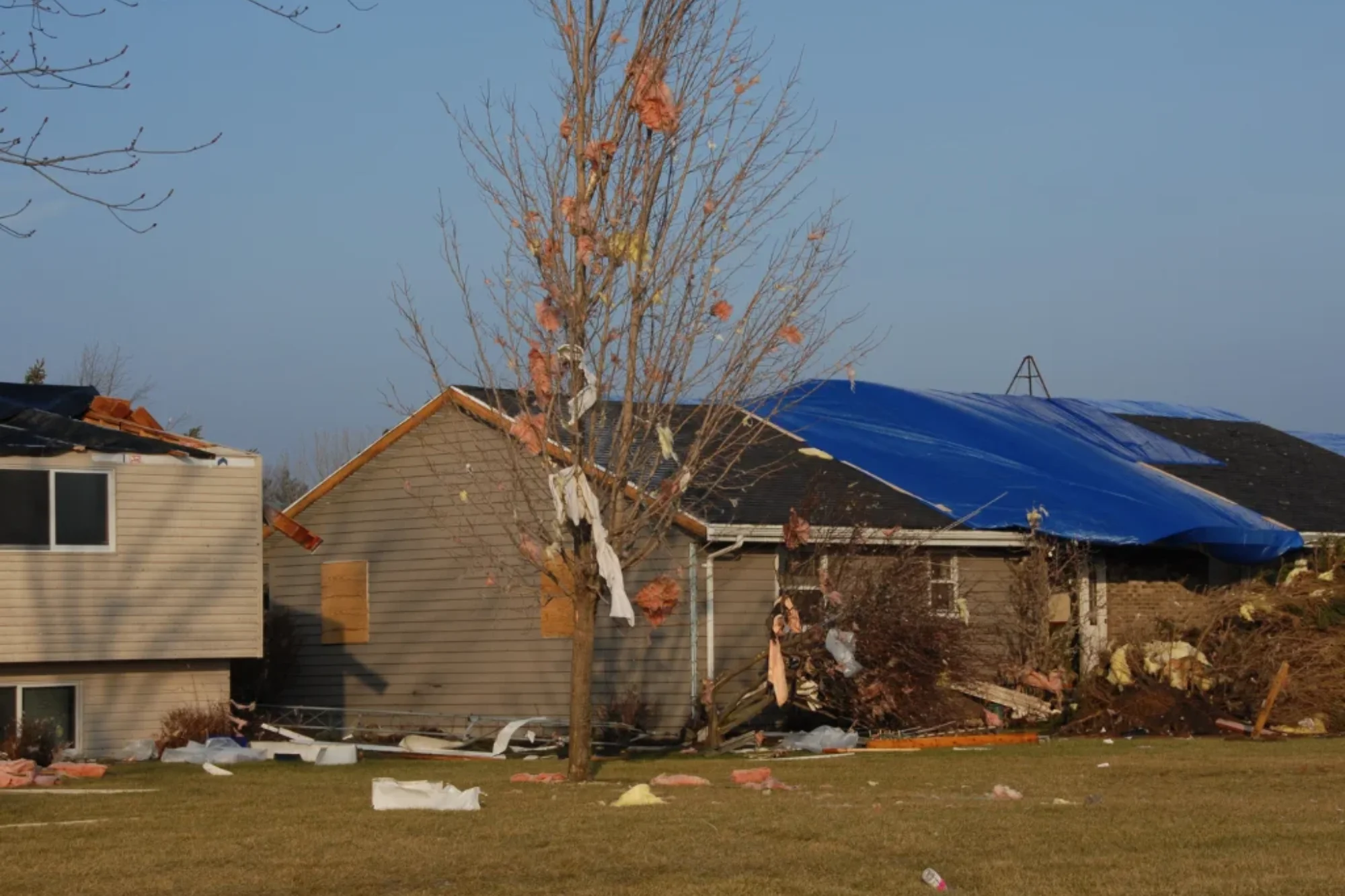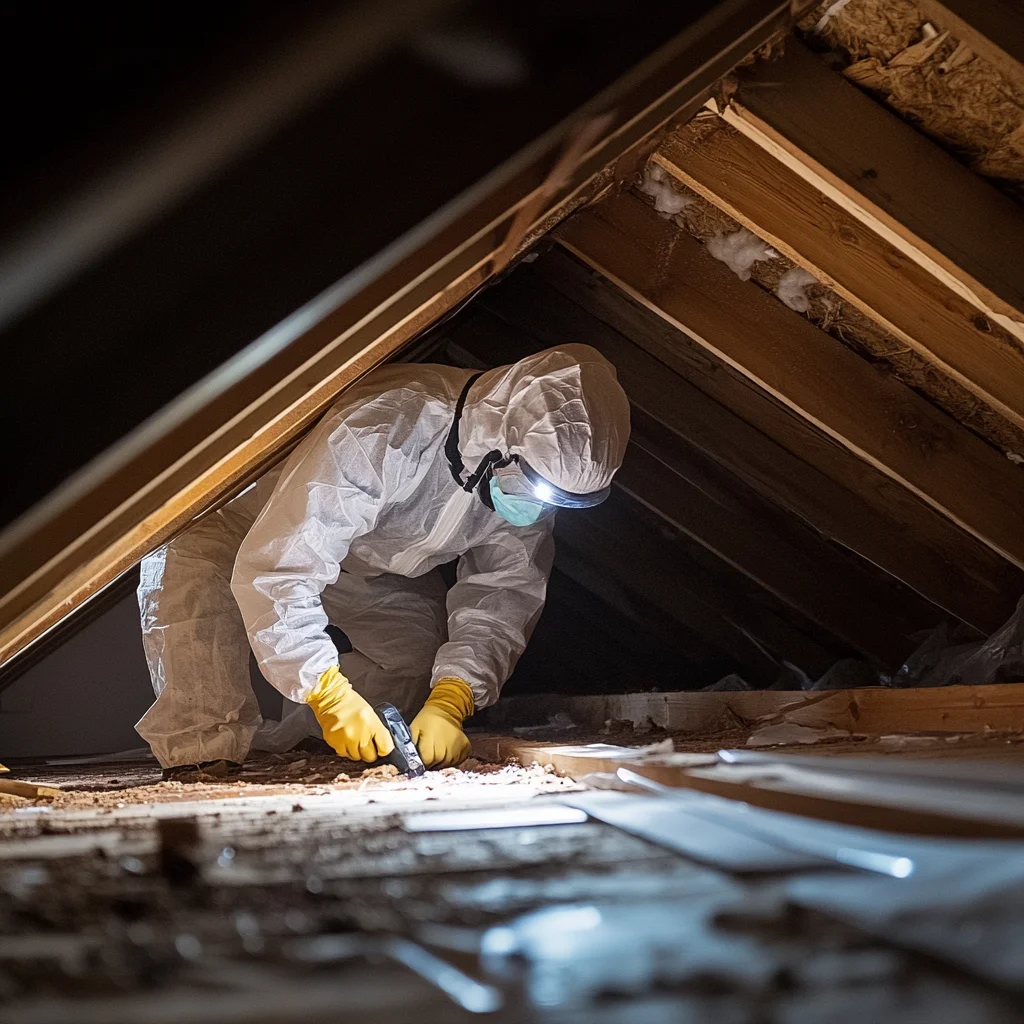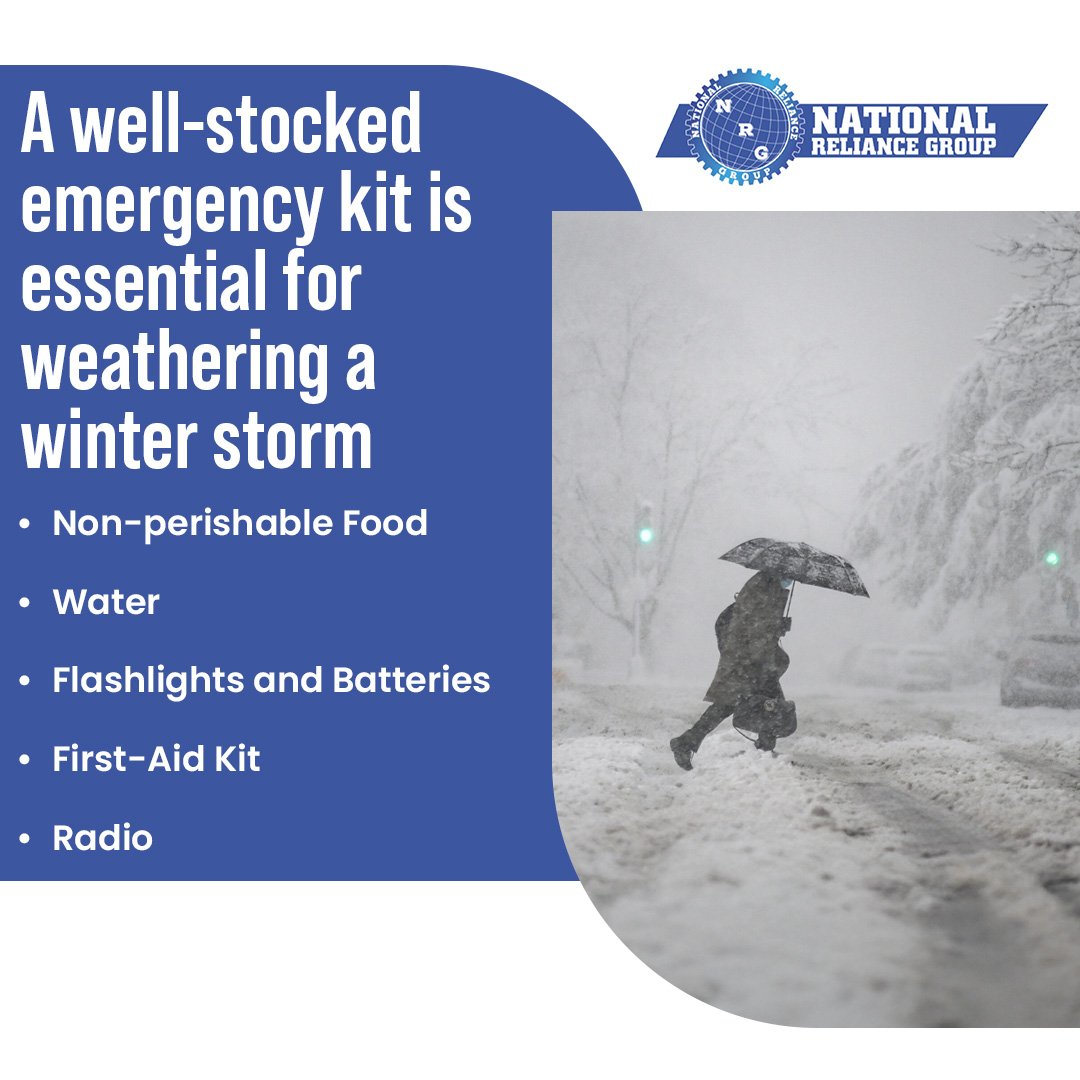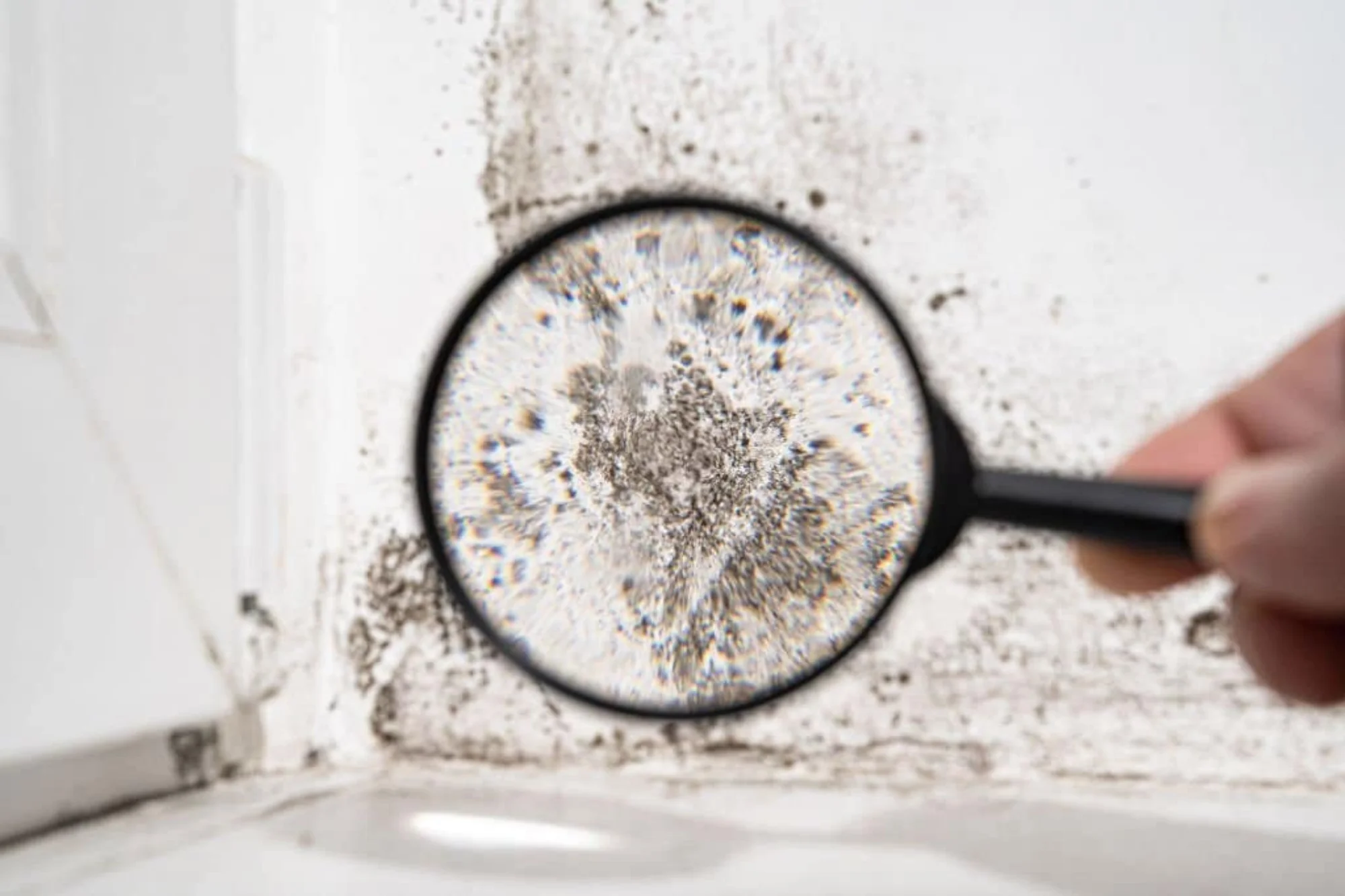Winter storms can wreak havoc on homes and businesses, causing power outages, property damage, and flooding. To protect yourself and your property, it’s essential to be prepared. In this blog post, we’ll discuss how to prepare for a winter storm, including tips for preventing water damage and what to do if your property is affected.
Water damage is a common consequence of winter storms, often resulting from burst pipes, flooding, or leaky roofs. To minimize the impact of water damage, it’s important to take preventive measures and know how to respond if a water damage emergency occurs.
Water damage restoration is the process of repairing and restoring property damaged by water. This involves removing excess water, drying affected areas, and repairing any structural damage. Water removal is the first step in the water damage restoration process and is of great importance to preventing further damage and mold growth.
National Reliance Group Roofing & Restoration is a company that specializes in water damage restoration and other restoration services. They can help you with water damage cleanup, water removal, and restoration, as well as other storm damage-related services.
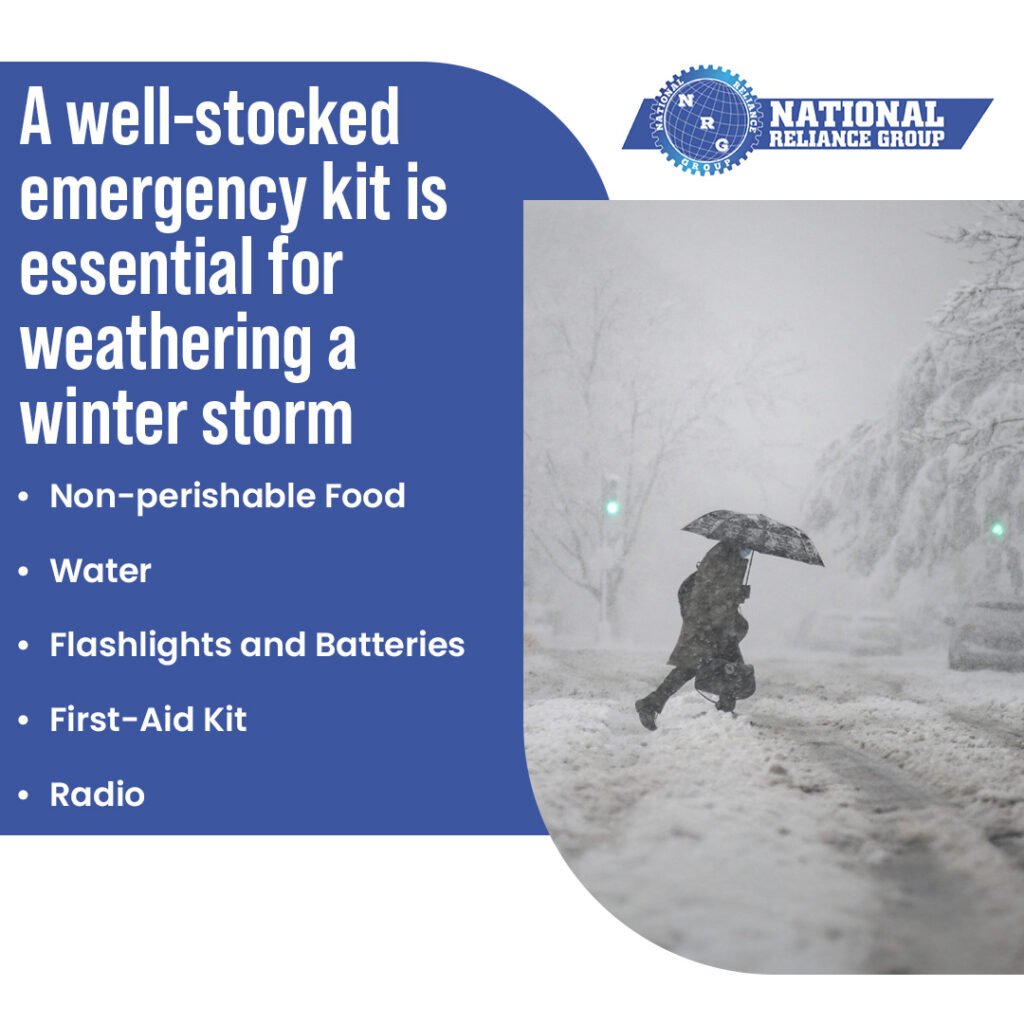
Understanding the Risks
The Impact of Winter Storms: Power Outages
Winter storms can lead to widespread power outages, causing substantial disruption to daily life.
Direct Consequences:
- Disruption of Essential Services:
- Heating and Cooling: Without electricity, maintaining comfortable indoor temperatures becomes challenging, especially during extreme cold or heat.
- Lighting: Darkness can hinder activities, increase safety risks, and disrupt sleep patterns.
- Water Supply: Electric pumps are often used to supply water to homes. Outages can lead to water shortages or pressure issues.
- Cooking and Refrigeration: Electric stoves, ovens, and refrigerators rely on electricity. Outages can spoil food and limit cooking options.
Indirect Consequences:
- Economic Impact:
- Business Disruptions: Businesses, especially those reliant on electricity, may face closures and revenue losses.
- Supply Chain Disruptions: Outages can affect transportation and logistics, leading to delays in the delivery of goods and services.
- Health Risks:
- Hypothermia and Frostbite: Without adequate heating, individuals, especially the elderly, young children, and those with health conditions, are at risk of hypothermia and frostbite.
- Carbon Monoxide Poisoning: Using alternative heating sources, such as generators or charcoal grills, indoors can lead to carbon monoxide poisoning, a silent killer.
- Social Disruption:
- Community Isolation: Power outages can limit communication and social interaction, especially for those who rely on technology to stay connected.
- Increased Crime: Reduced visibility and security systems can create opportunities for criminal activity.
Mitigating the Impact:
- Emergency Preparedness:
- Create an Emergency Kit: Stockpile essential supplies, including non-perishable food, water, flashlights, batteries, and a first-aid kit.
- Have a Family Emergency Plan: Establish a communication plan and designate a meeting point.
- Home Maintenance:
- Winterize Your Home: Insulate pipes, seal air leaks, and maintain your heating system.
- Trim Trees and Bushes: Remove any branches that could fall on power lines.
- Stay Informed:
- Monitor Weather Forecasts: Stay updated on weather conditions and potential power outages.
- Follow Local News and Emergency Alerts: Stay informed about emergency procedures and safety guidelines.
By understanding the potential impacts of winter storms and taking proactive measures, you can minimize the disruption to your life and protect yourself and your loved ones.
The Impact of Winter Storms: Fallen Trees, Flooding, and Structural Damage
Winter storms can cause considerable damage to property and infrastructure. Here’s a breakdown of some of the most common issues:
Fallen Trees and Debris
- Property Damage: Fallen trees can damage roofs, siding, and windows. Large branches can also cause damage to vehicles and other structures.
- Power Outages: Trees falling on power lines can lead to widespread power outages, disrupting essential services.
- Blocked Roads: Fallen trees and debris can block roads, making it difficult for emergency services to reach affected areas.
Flooding
- Water Damage to Homes and Businesses: Flooding can cause great water damage to homes and businesses, leading to mold growth, structural damage, and electrical hazards.
- Erosion: Heavy rainfall and flooding can erode soil, leading to landslides and other forms of land degradation.
- Contaminated Water: Floodwaters can be contaminated with sewage, chemicals, and other pollutants, posing health risks.
Structural Damage
- Roof Damage: Heavy snow and ice can damage roofs, leading to leaks and structural instability.
- Foundation Damage: Excessive water can saturate the ground, leading to foundation damage and settlement.
- Wind Damage: Strong winds can cause damage to siding, windows, and roofs.
Mitigating the Impact:
- Home Maintenance:
- Roof Inspection: Make sure your roof is in good condition and can withstand heavy snow and ice.
- Gutter Cleaning: Clean gutters to prevent water buildup and ice dams.
- Tree Trimming: Trim trees and shrubs to reduce the risk of falling branches.
- Emergency Preparedness:
- Create an Emergency Kit: Stockpile essential supplies, including non-perishable food, water, flashlights, batteries, and a first-aid kit.
- Have a Family Emergency Plan: Establish a communication plan and designate a meeting point.
- Insurance:
- Review Your Insurance Policy: Be sure you have adequate coverage for potential damages caused by winter storms.
- Review Your Insurance Policy: Be sure you have adequate coverage for potential damages caused by winter storms.
By taking proactive measures and being prepared, you can minimize the impact of winter storms on your property and well-being.
Identifying Vulnerable Areas in Your Home
Preparing your home for winter storms involves identifying vulnerable areas. Windows and doors are key concerns; air leaks can affect energy efficiency and allow water to enter. To prevent this, apply weatherstripping and caulk gaps, and consider installing storm windows.
The roof and gutters also require attention. Ice dams can block drainage, leading to leaks and damage, while clogged gutters can cause overflow. To prevent these issues, schedule regular roof inspections and keep gutters clear. Also, consider installing ice dam prevention systems.
Plumbing is another critical area; freezing temperatures can cause pipes to burst. Insulate exposed pipes, let faucets drip slightly to prevent freezing, and know how to operate your main water shut-off valve.
Addressing these areas can reduce the risk of damage and provide safety and comfort during winter storms.
Building an Emergency Kit
Essential Supplies for Winter Storm Preparedness
Be sure you and your family are prepared for a winter storm, and it’s necessary to have a well-stocked emergency kit. Here are some essential supplies to include:
Non-Perishable Food and Water
- Non-Perishable Food:
- Canned goods (soups, vegetables, fruits)
- Dried fruits and nuts
- Granola bars
- Ready-to-eat meals
- Crackers and cookies
- Water:
- Store bottled water or purify tap water using water purification tablets.
- Aim for at least one gallon of water per person per day.
Flashlights and Batteries
It’s essential to have a variety of flashlights, including headlamps and handheld models, for adequate lighting during a winter storm. Stock up on different battery sizes to power flashlights, radios, and other devices. Investing in rechargeable batteries and a portable charger can provide reliable power during outages. An emergency radio that receives AM/FM and NOAA Weather Radio broadcasts is critical for updates on weather conditions and safety tips. By gathering these supplies, you’ll be better prepared for harsh winter weather.
First-Aid Kit
For a well-stocked first aid kit, include assorted bandages like adhesive types and gauze pads, along with antiseptic wipes for cleaning wounds. Over-the-counter pain relievers such as acetaminophen or ibuprofen are important for managing discomfort. Antihistamines provide allergy relief, and a thermometer is necessary for monitoring fever. Additionally, include tweezers for removing splinters and scissors for cutting bandages. Don’t forget disposable gloves to protect yourself from germs while administering care.
Warm Clothing and Blankets
When preparing for cold weather, warm clothing is essential to keep you comfortable. Heavy coats, hats, gloves, and scarves are important items that can help shield you from the chill. Additionally, thermal underwear provides an extra layer of insulation, ensuring that you stay warm even in freezing temperatures. Waterproof boots are also a must-have, as they protect your feet from moisture and keep them warm and dry.
In addition to clothing, having ample blankets is important for warmth. Wool blankets or sleeping bags serve as excellent sources of insulation, helping to maintain body heat during cold nights. Overall, these items are vital for staying cozy and safe in harsh winter conditions.
By having these essential supplies on hand, you can be prepared to weather a winter storm and minimize its impact on your daily life.
Creating a Family Emergency Plan: Establishing a Meeting Point
Establishing a designated meeting point is an essential component of any family emergency plan. This location should be safe and easily accessible so that family members can reunite in case of an emergency, such as a winter storm.
Choosing a Meeting Point:
When selecting a meeting point, consider the following factors:
- Accessibility: The location should be easily reachable by all family members, regardless of transportation methods.
- Safety: The meeting point should be a safe place, away from potential hazards like flood zones or areas prone to falling debris.
- Familiarity: Choose a location that is familiar to all family members.
- Neutral Ground: Avoid choosing a location that is tied to a specific family member’s home, as this may not be accessible in case of widespread damage or evacuation orders.
Possible Meeting Point Options:
- A Designated Public Place: A local park, library, or community center can serve as a neutral meeting point.
- A Neighbor’s House: If you have a trusted neighbor who lives in a safe area, their home can be a designated meeting point.
- A Specific Location Within Your Neighborhood: A landmark, such as a particular tree or street corner, can be used as a reference point.
Additional Tips:
- Share the Meeting Point with All Family Members: Make sure that everyone knows the location and how to get there.
- Have a Backup Plan: In case the primary meeting point is inaccessible, consider a secondary location.
- Practice Your Plan: Conduct regular family emergency drills to familiarize everyone with the plan and to identify any potential issues.
By establishing a clear meeting point and practicing your emergency plan, you can increase your family’s chances of reuniting safely during a winter storm or other emergency.
Designing a Communication Plan
Effective communication is essential during an emergency. Here are some tips for creating a communication plan:
- Identify Primary Contacts: Designate primary contacts for each family member.
- Establish a Communication Method: Choose a reliable method of communication, such as cell phones, landlines, or social media.
- Develop a Code Word or Phrase: Use a specific code word or phrase to signal an emergency.
- Have a Backup Plan: If your primary communication method fails, have a backup plan, such as a designated meeting place or a neighbor’s phone number.
- Practice Your Plan: Regularly practice your communication plan to be sure that everyone knows how to use it.
Practicing Emergency Drills
Regularly practicing emergency drills can help your family respond effectively to a winter storm or other emergency. Here are some tips for conducting effective drills:
- Simulate Different Scenarios: Practice a variety of scenarios, including power outages, evacuations, and shelter-in-place orders.
- Involve All Family Members: Make sure everyone, including children, participates in the drills.
- Time Your Drills: Time how long it takes your family to gather necessary supplies and evacuate your home.
- Review and Adjust: After each drill, review your family’s performance and adjust your plan as needed.
By following these tips, you can create an extensive family emergency plan that will help you stay safe and informed during a winter storm.
Winterizing Your Home: Insulating for Energy Efficiency
Proper insulation is a must for preparing your home for the harsh winter months. It helps maintain a comfortable indoor temperature, reduces energy consumption, and lowers heating costs.
Sealing Air Leaks
Air leaks can highly impact your home’s energy efficiency. To identify and seal these leaks, follow these steps:
- Visual Inspection: Look for gaps around windows, doors, electrical outlets, and baseboards.
- Use a Smoke Pencil: Light a smoke pencil and waft the smoke around potential leak areas. Watch for the smoke to be drawn into any gaps.
- Caulking: Use caulk to seal gaps around windows, doors, and other openings.
- Weatherstripping: Apply weatherstripping to doors and windows to create a tight seal.
Adding Insulation
Proper insulation helps to regulate your home’s temperature by preventing heat loss in winter and heat gain in summer. Here are some key areas to consider:
- Attic Insulation: The attic is one of the most critical areas to insulate. Adequate insulation can substantially reduce heat loss through the roof.
- Wall Insulation: Insulating walls can improve energy efficiency and soundproofing.
- Basement Insulation: Insulating basement walls and floors can help prevent moisture problems and energy loss.
When adding insulation, consider these factors:
- Insulation Material: Based on your specific needs and budget, choose an appropriate insulation material, such as fiberglass, cellulose, or spray foam.
- Insulation R-Value: The R-value measures the insulating effectiveness of a material. Higher R-values provide better insulation.
- Professional Installation: While DIY insulation is possible, professional installation often provides optimal results and avoids potential mistakes.
By sealing air leaks and adding insulation, you can create a more energy-efficient and comfortable home while also reducing your carbon footprint.
Winterizing Your Home: Protecting Your Plumbing System
A well-protected plumbing system is essential to prevent costly water damage during winter. Here are some key steps to safeguard your pipes:
Insulating Pipes
Insulating pipes helps to maintain a warm temperature and prevent freezing. Here are some tips:
- Identify Vulnerable Pipes: Focus on pipes located in unheated areas, such as basements, attics, and exterior walls.
- Insulation Materials: Use pipe insulation sleeves or foam pipe wrap to insulate pipes.
- Secure Insulation: Ensure the insulation is securely fastened to the pipes to prevent it from slipping.
- Heat Tape: For extra protection, consider using heat tape on particularly vulnerable pipes. However, follow manufacturer instructions carefully and make sure the electrical connections are proper.
Draining Outdoor Faucets
Outdoor faucets are susceptible to freezing, which can lead to pipe damage. To prevent this:
- Turn Off the Water Supply: Locate the shut-off valve for your outdoor faucets and turn it off.
- Drain the Pipes: Open the outdoor faucet to drain any remaining water.
- Disconnect Garden Hoses: Remove garden hoses from outdoor faucets to prevent water from freezing and backing up into the pipes.
By following these steps, you can greatly reduce the risk of frozen and burst pipes, protecting your home from water damage and costly repairs.
Winterizing Your Home: Maintaining Your Heating System
A well-maintained heating system is essential for keeping your home warm and cozy during the winter months. Here are some essential maintenance tips:
Scheduling Professional Maintenance
- Annual Tune-Up: Schedule a professional tune-up before the start of the heating season.
- Inspection and Cleaning: A technician will inspect your heating system, clean its components, and identify any potential issues.
- Efficiency Check: They will also check the efficiency of your system and make adjustments as needed.
Cleaning Filters and Vents
- Air Filters: Regularly clean or replace air filters to improve air quality and system efficiency.
- Vents: Clean vents and registers to confirm proper airflow.
- Chimney Cleaning: If you have a fireplace or wood-burning stove, schedule a professional chimney cleaning to remove creosote buildup and reduce the risk of chimney fires.
By following these maintenance tips, you can make sure your heating system operates efficiently, safely, and reliably throughout the winter.
Coping with a Power Outage: Staying Warm and Safe
A power outage during a winter storm can be a challenge. Here are some tips to stay warm and safe:
Dressing in Layers
- Wear Warm Clothing: Layer your clothing to trap heat. Start with a thermal base layer, followed by a sweater or fleece and a warm outer layer.
- Headwear: Wear a hat to keep your head warm.
- Footwear: Wear warm socks and insulated boots.
Using Alternative Heating Sources Safely
If you need to use alternative heating sources during a power outage, it’s critical to do so safely:
- Portable Generators:
- Use generators outdoors, away from windows and doors.
- Never run a generator in enclosed spaces, as this can lead to carbon monoxide poisoning.
- Connect appliances directly to the generator, avoiding extension cords.
- Fireplaces and Wood-Burning Stoves:
- Have your chimney cleaned regularly to prevent creosote buildup.
- Use dry, seasoned wood.
- Never leave a fire unattended.
- Use a fireplace screen to prevent sparks and embers from escaping.
- Space Heaters:
- Place space heaters on a level, hard surface, away from flammable materials.
- Never use a space heater to dry clothes.
- Turn off space heaters when you leave the room or go to sleep.
Conserving Heat
- Close Off Unused Rooms: Close doors to rooms that aren’t being used to conserve heat.
- Insulate Windows and Doors: Use blankets or towels to seal gaps around windows and doors.
- Cook on a Stovetop: Use a stovetop to heat food and water.
- Use a Fireplace or Wood-Burning Stove: If you have one, use it to heat your home. However, proper ventilation and safety precautions must be ensured.
By following these tips, you can stay warm and safe during a power outage. Remember to prioritize safety and avoid taking unnecessary risks.
Dealing with Storm Damage
Assessing the Damage
After a storm, it’s important to evaluate the extent of the damage to your property.
Identifying Structural Damage:
- Roof Inspection: Check for missing or damaged shingles, leaks, and structural damage.
- Wall and Ceiling Inspection: Look for cracks, water stains, and signs of sagging.
- Foundation Inspection: Examine the foundation for cracks, settling, or water damage.
Checking for Water Damage:
- Visible Water Damage: Look for standing water, water stains, and damp areas.
- Hidden Water Damage: Use a moisture meter to detect hidden water damage in walls, floors, and ceilings.
- Mold Inspection: Check for signs of mold growth, such as musty odors, discoloration, and visible mold.
Water Damage Cleanup
If your property has sustained water damage, it’s important to act quickly to prevent further damage and mold growth.
Removing Standing Water:
- Use Pumps: Use submersible pumps to remove large amounts of water.
- Use Towels and Mops: Smaller amounts of water removal can be done using mops or towels.
Drying Affected Areas:
- Open Windows and Doors: Increase airflow to help dry the area.
- Use Dehumidifiers: Place dehumidifiers in affected areas to remove moisture from the air.
- Use Fans: Use fans to circulate air and speed up the drying process.
Preventing Mold Growth:
- Clean and Disinfect: Clean and disinfect all affected surfaces with a mold-killing solution.
- Dry Thoroughly: Make certain that all affected areas are completely dry.
- Monitor for Mold: Regularly check for signs of mold growth and address any issues promptly.
Hiring a Professional Restoration Company
If the damage is extensive, it may be necessary to hire a professional restoration company.
Identifying Reputable Companies:
- Check Online Reviews: Read reviews from past clients.
- Verify Licensing and Insurance: Confirm that the company is licensed and insured.
- Ask for References: Request references from past clients.
Understanding Insurance Claims:
- Document the Damage: Take photos and videos of the damage.
- Contact Your Insurance Company: Notify your insurance company promptly and provide them with the necessary documentation.
- Work with Your Insurance Adjuster: Cooperate with your insurance adjuster to receive a fair settlement.
By following these steps and seeking professional help when needed, you can minimize the impact of storm damage on your property.
Storm Damage in Doraville, GA
Common Storm Damage Issues in Doraville
Doraville, GA, like many areas in the region, is susceptible to various types of storm damage. Some of the most common issues include:
- Flooding: Heavy rainfall, especially during tropical storms or hurricanes, can lead to localized flooding in low-lying areas. Flash flooding can also occur during intense thunderstorms.
- Wind Damage: Strong winds associated with thunderstorms, hurricanes, or tornadoes can cause considerable damage to roofs, siding, and trees.
- Tree Damage: High winds can uproot trees or cause large branches to fall, potentially damaging property and power lines.
Local Resources for Storm Damage Cleanup
If your property in Doraville is affected by storm damage, here are some local resources to help you with cleanup and restoration:
Emergency Services:
- DeKalb County Emergency Management Agency: Contact them for emergency assistance and information.
- DeKalb County Fire Department: Call them for fire-related emergencies or if you need immediate assistance.
Debris Removal Services:
- Local Junk Removal Companies: Many local junk removal companies can help you remove debris from your property.
- City of Doraville Public Works Department: Contact them for information on debris removal and disposal.
Restoration Companies:
- National Reliance Group: As mentioned earlier, they are a reputable restoration company that can assist with water damage, fire damage, and mold remediation.
- Other Local Restoration Companies: Research and choose a reputable restoration company that specializes in storm damage restoration.
Additional Tips:
- Document the Damage: Take photos and videos of the damage to your property.
- Contact Your Insurance Company: Notify your insurance company promptly and provide them with the necessary documentation.
- Be Patient: Water damage restoration can take time, so be patient and work with professionals to make certain of a thorough and efficient cleanup.
By being prepared, understanding potential risks, and knowing where to seek help, you can minimize the impact of storm damage on your property and well-being.
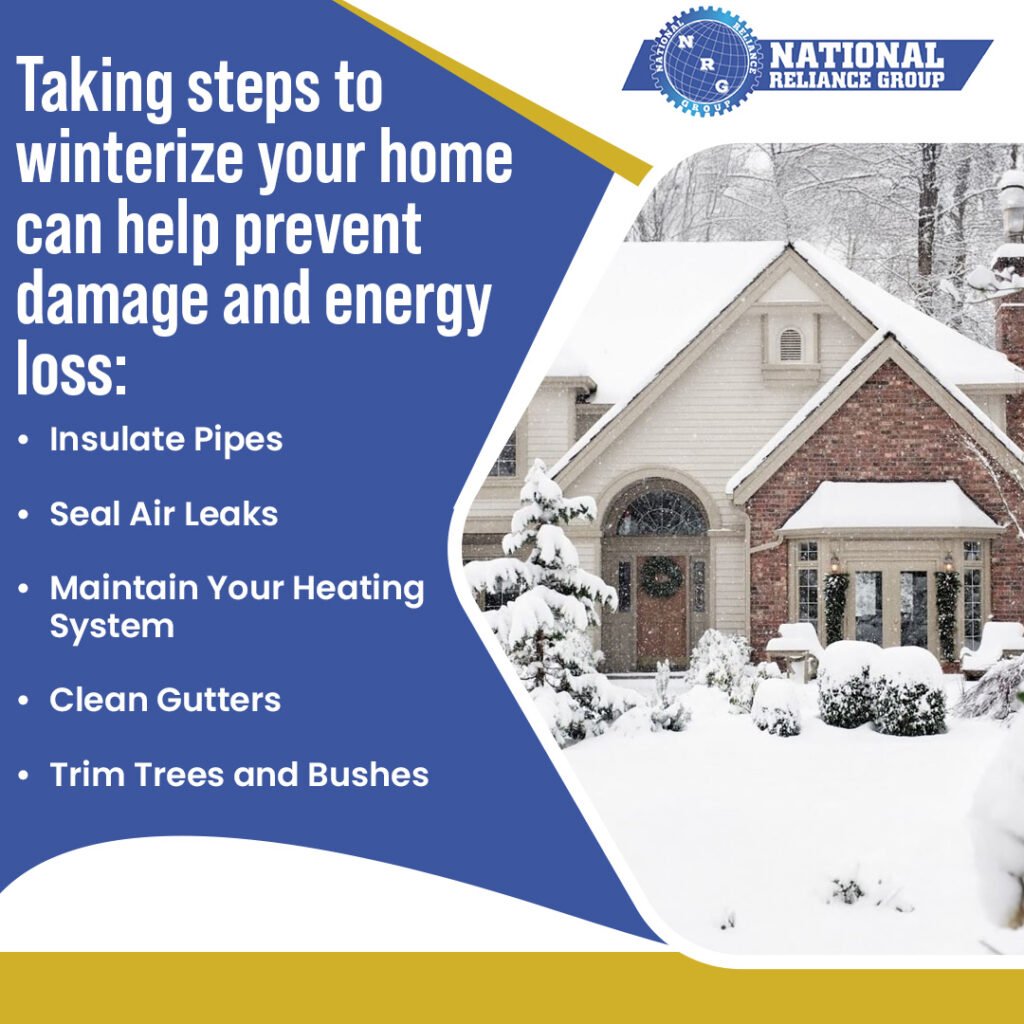
National Reliance Group
National Reliance Group is a trusted provider of complete restoration services in the Atlanta area. Specializing in water damage restoration, fire damage remediation, mold remediation, and storm damage mitigation, they are committed to restoring properties to their pre-loss condition. With a team of skilled professionals and advanced equipment, they offer rapid response, efficient service, and personalized solutions. Whether it’s a minor water leak or a major disaster, National Reliance Group is dedicated to helping clients navigate the restoration process smoothly. Their expertise, combined with a focus on customer satisfaction, makes them a reliable choice for all your restoration needs.
Don’t let storm damage leave you feeling overwhelmed. National Reliance Group is here to help! Our team of restoration specialists are available 24/7 to handle water damage, fire damage, mold remediation, and more. We’ll work swiftly and efficiently to get your property back to its pre-loss condition. For a free consultation, call us at (770) 674-1748 or contact Anthony directly at anthonyr@nationalreliancegroup.com. Don’t wait. Take action today!

